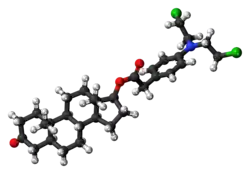 | |
 | |
| Clinical data | |
|---|---|
| Other names | Testiphenon; Testiphenone; Chlorphenacyl dihydrotestosterone ester; Dihydrotestosterone 17β-(4-(bis(2-chloroethyl)amino)phenyl)acetate; LS-19378 |
| Identifiers | |
| |
| CAS Number | |
| PubChem CID | |
| ChemSpider | |
| UNII | |
| CompTox Dashboard (EPA) | |
| Chemical and physical data | |
| Formula | C31H43Cl2NO3 |
| Molar mass | 548.59 g·mol−1 |
| 3D model (JSmol) | |
| |
| |
Testifenon, also known as testiphenon, testiphenone, chlorphenacyl dihydrotestosterone ester, or dihydrotestosterone 17β-(4-(bis(2-chloroethyl)amino)phenyl)acetate, is a synthetic anabolic–androgenic steroid (AAS) and a cytostatic antineoplastic agent (i.e., chemotherapeutic) that was never marketed.[1][2][3] It is an androgen ester – specifically, a chlorphenacyl nitrogen mustard ester of dihydrotestosterone (DHT) – and acts as a prodrug of these two components in the body.[1][2] The drug was developed in Russia as a tissue-selective cytostatic drug for the treatment of various cancers occurring in androgen receptor-expressing tissues that would have reduced side effects and toxicity relative to other chemotherapy drugs.[1][2]
See also
References
- 1 2 3 Lagova ND, Sof'ina ZP, Shkodinskaia EN, Kurdiumova KN, Valueva IM (1988). "[The antineoplastic activity of testiphenon]". Voprosy Onkologii (in Russian). 34 (11): 1363–1368. PMID 3201773.
- 1 2 3 Demidova NV, Serebryakova EA, Gasan-Guseinova ZG, Zimakova NI, Arzamastsev AP (November 1995). "Comparative pharmacokinetics of 3H-testiphenone and 3H-chlorophenacyl in peroral administration to mice". Pharmaceutical Chemistry Journal. 29 (11): 737–739. doi:10.1007/BF02331848. S2CID 31434647.
- ↑ Oborotova NA, Smirnova ZS, Polozkova ZS, Baryshnikov AI (2002). "[Pharmacological aspects in the development of liposomal medicinal preparations for the internal injection of hydrophobic cytostatics]". Vestnik Rossiiskoi Akademii Meditsinskikh Nauk (in Russian) (1): 42–45. PMID 11882971.
This article is issued from Wikipedia. The text is licensed under Creative Commons - Attribution - Sharealike. Additional terms may apply for the media files.